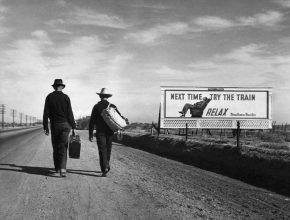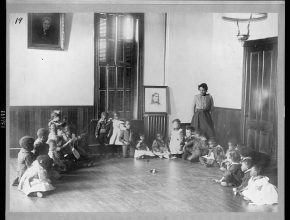Southern Legitimacy Statement: I grew up in Missouri and moved to Georgia almost fifty years ago as a VISTA (Volunteers in Service to America) volunteer. After over three decades of service, I retired from Georgia state government.
Would They Do It Again?
From 1964 to 1968, a handful of Black students integrated many all-white schools in the South. They entered under “freedom of choice” plans, a little-known undertaking, launched as a last-ditch attempt by Southern states to resist wholesale desegregation. The African American students encountered defiant educational establishments in which white pupils outnumbered them by a hundredfold or more. Taunted, spit on, pushed, and mistreated, the Black students, with few exceptions, received no support from teachers, administrators, and passive white classmates. By chance, I came across an oral history of two sisters who sustained this torment for four years. One of them, Sherry, was a woman I had lost touch with three decades in the past. As I read her words, in my mind, I could see Sherry’s image and hear her voice. Even though I could have absorbed their account in thirty minutes, it disturbed me so much I kept putting it down. It took four uncomfortable sittings over two days to finish.
I found other oral histories, compiled by the College of Charleston, of former students who were among the first to desegregate Southern schools. Before 1968 they had the option of going back to the Black schools, which raised questions in my mind: Given the mistreatment, why did they stay? Did they feel they made the right choice? And, thinking about my talks with Sherry, another question emerged that I need to answer: How do her views on her experience affect me?
Why did they stay?
In their interviews, these pioneers gave many reasons for staying; the most consequential was their parents. “You going to that school to learn. That’s your whole purpose for being there, [it]is to learn…You’re just as good as anybody else. You can learn just as much as anybody else,” Gloria Carter’s mother told her and her sisters. Their mother gave more than pep talks; she helped them deal with the stress. When they got home from school, she listened as they told her about their day. She would “reinforce that we were there for a purpose, that we were there to learn. And whatever they [white students] learned that we could learn.” Then after the listening session, she led them in song. “We’d sing like ‘Woke Up This Morning With My Mind’… she was saying when you sing, it makes you feel good about yourself…she started singing, and [we would] forget what happened that day.” Encouraged by her mother, Carter resolved “to finish whatever I had started.”
Some parents balanced loving encouragement with stern words. Millicent Brown recalled a time when she asked her father to “‘let me go back to the Black school. Please let me go back.’ And he said, ‘No, you have to stick with it. Somebody [has] got to do it.’”
Support for staying also came from extended families as Theodore Adams relates, “I mean my momma was there, my daddy, all my aunts, my uncles, my cousins. I couldn’t have gotten through it without them.” Lucy Frinks said, “[W]e needed to make a change…[that] was awful at some points, but there was never a time when we felt like we weren’t cared for or loved by our family. And that was, I would say, the saving grace for all of us.” She and her cousins, who were among the integration firsts in their school district, knew their family was “going to stand up for us, that they were going to love us. And that’s a powerful thing to know that you have that.”
The civil rights movement bolstered the resolve of a few of the firsts. “[W]e were always involved in the movement—picketing, whatever…we volunteered,” said Theodore Adams. Millicent Brown’s father was the president of the state NAACP chapter, and her parents set out to enroll her sister and, later, her after the Brown v. Board of Education decision in 1954. The white school refused to admit them, but they did not give up. They filed a lawsuit “with the guidance and advice of the NAACP.” In 1963, a federal court ruled she and eight other plaintiffs could attend the all-white schools in Charleston, South Carolina.
African American religious leaders and their congregations played a prominent role in the civil rights activities of the 1960s, and most active participants were people of faith. Though they didn’t cite religion as a primary factor, a couple of the firsts noted its import. “The Orangeburg [South Carolina] movement came out of the Black church and…the Black church in Orangeburg said that change had to happen and didn’t back away from it,” said Theodore Adams. Gloria Carter’s mother told her, “once we’d go to school, she’d pray for us all day long. She’d pray for her kids, and asked the Lord to bring her kids home safe.”
When I asked Sherry why she remained at the white school, she gave a response in line with the accounts I’d read. She and the other Black students knew they couldn’t let the racists beat them. Their parents expected them to stay; their community expected them to stay; they knew they couldn’t quit without losing self-respect. It was apparent to me she understood, at the age of thirteen, she was fighting for a greater good, representing people resisting oppression.
I can’t imagine the anguish these children and adolescents went through. The closest I’ve come to it was a period in my senior year of high school, during which other kids intimidated and embarrassed me on the school bus. Every morning I’d get on the bus and couldn’t find a seat, but it wasn’t for lack of space. There would be three or four spots where a boy would sit with a leg sprawled out, taking the space of two people. When I asked to sit, they rebuffed me, saying “no,” or they ignored me, acting as if I wasn’t there. I had to stand, humiliated. I begged my parents to repair an old car they owned so I could drive to school. They relented after a couple of months, freeing me from the agony, but my disgrace remained. While at home, I wouldn’t go outside—even washing the old car in the garage with the door closed—afraid the bullies would see and mock me. In these trivial incidents, a few teenage boys humbled but didn’t harm me. I didn’t react by insisting on a seat or ignoring them by standing by in quiet self-respect. I lost face, and I withdrew, timid and sorry for myself. If I had been in the place of one of the Black pioneers, I would have behaved the same as I did on the bus, retreating to a safe and secure environment.
Was it the right choice?
Attacking the racial barriers to a sound education, these young African Americans engaged in a historic effort. Yet they were children. “I hated that decision,” Lucy Frinks said, referring to how she reacted when told she will be going to an all-white school, “I lost every friend I had.” Gloria Carter said, “We’d sit in that classroom, we took those spitballs, we did all of that, and we hated to go.” They asserted their right to integrated schooling, but she felt it “was a cruel thing… being treated like we weren’t even human… to get something changed in the [segregated] system.”
Interviewers asked a few respondents if given a choice would they do it again. “[A]t this point I don’t have any regrets, but if I had to do it over again I would not have done it as a young kid,” related Carlton Wilson, who started going to an integrated school in the fourth grade, “because it eliminated the fun in my life…I was traumatized.” He wondered, “why me? I thought you wanted me to be happy and to learn,” he continued, referring to his elders, “but are you sacrificing me for a larger cause?”
Emma Harvin was blunt: “If I had a choice? If I had a choice, I would stick with the all-black school.” There she would get the support a young person needs from teachers and counselors. “I would want [to attend] the all-black school to have the advantage to know everything out there.”
When the interviewer asked Theodore Adams if he ever said to himself, “It’s not worth it,” he answered, “Not then. There was a time though that I did.” Years later, he had second thoughts when drugs became a problem in the community, and “there were more black males in jail than in school…[B]ut now I’m back to I’m glad I did it.”
After we had a couple of discussions about her high school years, I questioned Sherry about whether she would do it again. By then, I was sure I knew what she would say. I was presumptuous. She replied, without hesitating or elaborating, she would not do it again because it wasn’t worth it. Her response puzzled me. When she was a student, she could have gone back to the Black school at any time but didn’t, so I couldn’t figure why, if fate had turned back the clock, she would not have chosen to integrate the white institution. I had a twinge of dismay that I attempted to suppress, but must not have because she sent an email later in the day, giving me more detail. “[T]he price was just too high…I gave up my adolescence/childhood for something that” had little effect. And she noted, being in their early teens, she and her sister were too young, as was her brother who was in the third grade.
Several months after our conversation, Sherry loaned me a video of the oral history she and her sister gave. The interview lasted two hours, but the staff didn’t transcribe all of it, so the contents of the last half were new to me. During hour two, a question came up about desegregation’s effect on them. Sherry replied, “it cost me a lot. I’ve often said, much to my white friend’s chagrin, that I wish I hadn’t done it.” Her answer didn’t surprise me since earlier she had told me she wouldn’t go through the ordeal again. Still, the disappointment I had hearing it in person came back to me as I listened to the recording. To use her term, I felt chagrin.
* * *
After a white supremacist murdered nine people in a Black Charleston church, the surviving victims and family members forgave the killer. Concerning the many whites who voiced approval of this extraordinary mercy, Chris LeBron, in a New York Times piece, observed: Because the killer represented a culture of racism and white privilege, to pardon him, “is to extend an act of forgiveness to that culture and its beneficiaries…[and] this is an act that has been expected of Blacks enduring racism in this country since the 17th century.” He asked, “Do the folks who applauded forgiveness grasp that historical dynamic?”
Considering if they would again subject themselves to the trauma of integrating an all-white school, Sherry and the other firsts would have to weigh the advantages of answering yes. By saying they would, they convey they have faith their suffering had a positive effect, and doing it again would contribute to a more just society for them and all African Americans. When Sherry said she wouldn’t do it again, we—her white friends, including me—were chagrined. We didn’t understand her position, but why the personal unease? Was it because she was saying, “I cannot forgive those who mistreated me and their passive enablers,” who, in line with LeBron’s observation, represent a racist culture? And by extension, those who have benefitted from that culture cannot be forgiven, denying us the absolution we seek?







